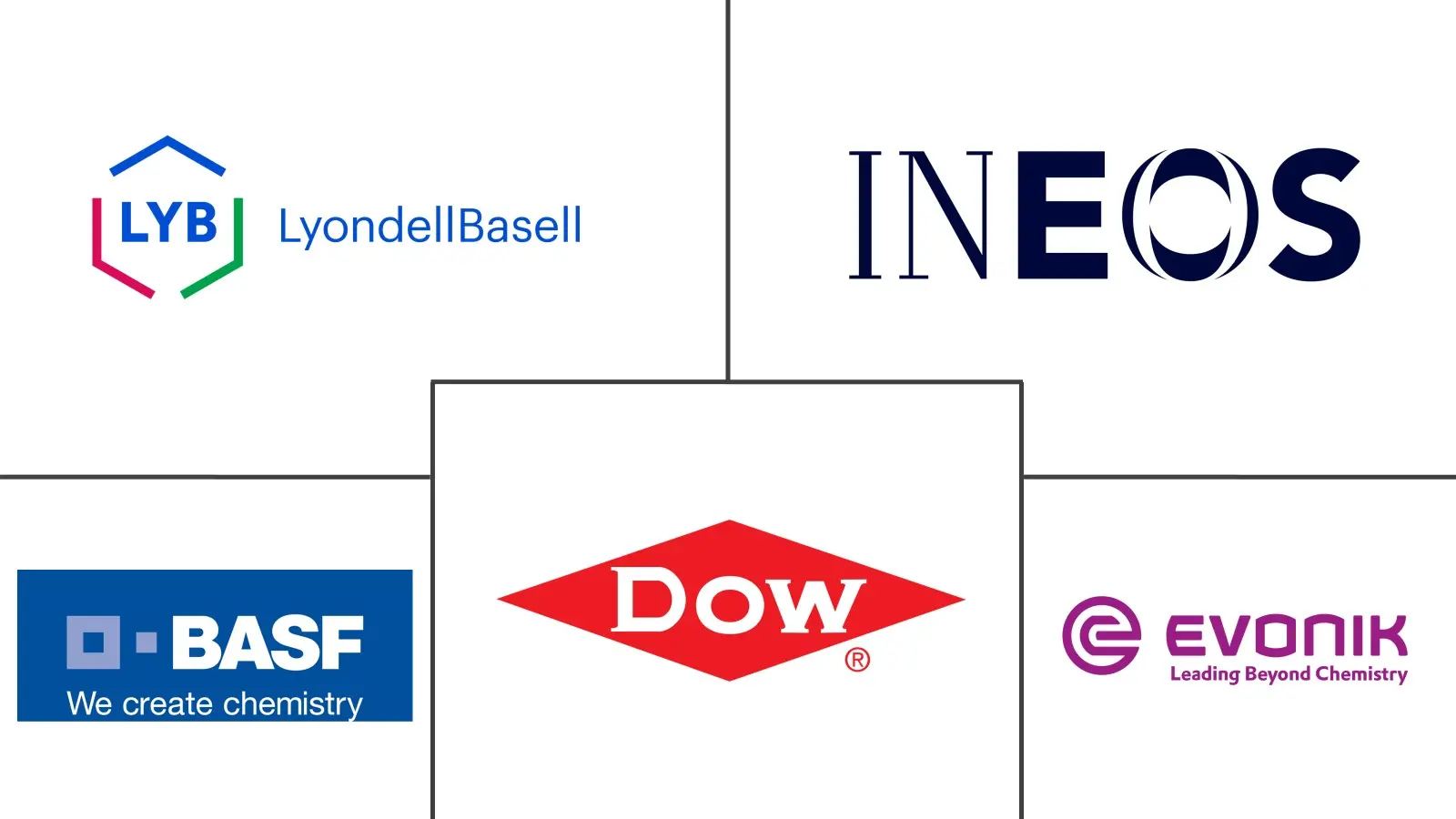Germany Propylene Glycol Market Size and Share
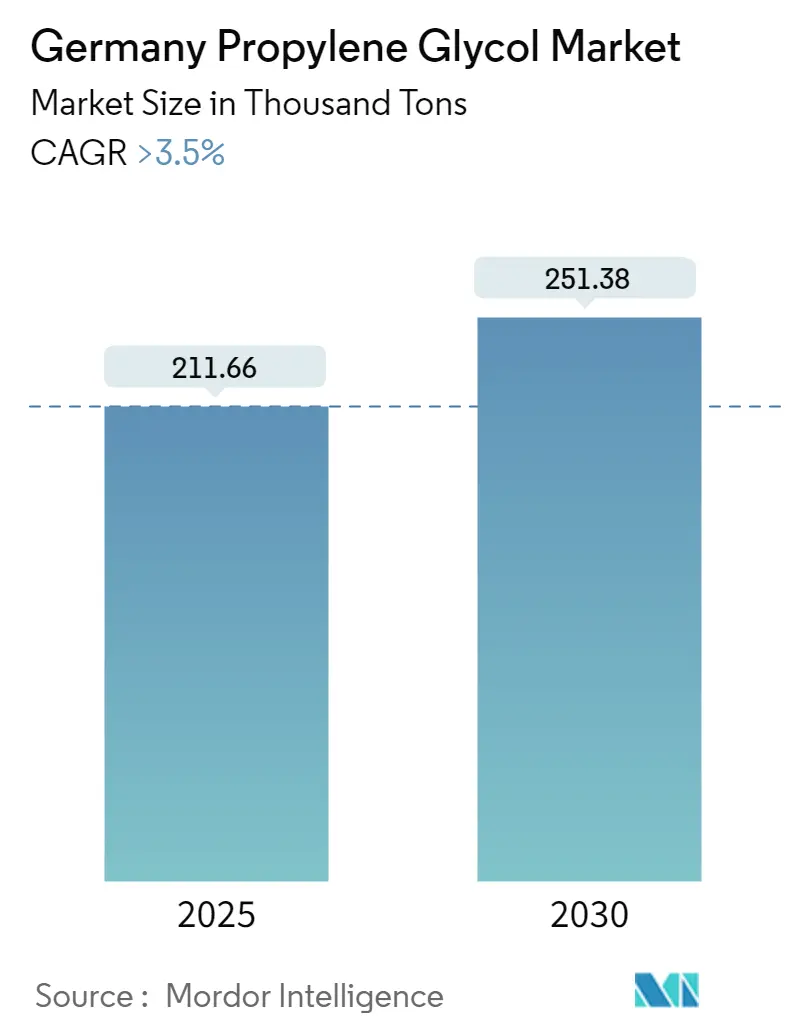
Germany Propylene Glycol Market Analysis by Mordor Intelligence
The Germany Propylene Glycol Market size is estimated at 211.66 thousand tons in 2025, and is expected to reach 251.38 thousand tons by 2030, at a CAGR of greater than 3.5% during the forecast period (2025-2030).
The COVID-19 pandemic had negatively impacted the market due to nationwide lockdowns, strict social distancing measures, and disruption in supply chains, which negatively affected the transportation, building, and construction end-user industries, thereby affecting the market for propylene glycol. However, the market recovered well after the restrictions were lifted. The market recovered significantly, owing to the rise in consumption of propylene glycol in transportation and pharmaceutical end-user industries.
Over the medium term, the increasing demand from the food-processing and additives industry, the growing demand from the automotive industry, and the rising demand for solvents from various end-user industries are expected to drive the market for propylene glycol in the country.
On the flip side, the health issues created by the high consumption of propylene glycol are expected to hinder the market's growth.
However, developing industrial-scale direct synthesis methods for propylene glycol production is expected to create opportunities for the market during the forecast period.
Germany Propylene Glycol Market Trends and Insights
Transportation Industry to Dominate the Market
- Propylene glycol is widely used in the transportation sector. It is a viscous, colorless, and odorless liquid. It is highly hygroscopic and soluble in alcohols, esters, water, amines, and ketones. It has limited miscibility with halogenated hydrocarbons and is not miscible with aliphatic hydrocarbons. It has a wide variety of applications in the transportation industry.
- Propylene glycol is used to produce fire-resistant brake and hydraulic fluids, coolants used in the transportation industry for applications like engine cooling, and, as an initial for raw materials of paints, as a raw material for de-icing of planes, and as a heat transfer fluid for high-temperature applications. Propylene glycol is also used to prepare unsaturated polyester resins, which have various roles in transportation.
- The consistent investments in R&D activities and the increasing automotive production in the country are the factors that are likely to support the growth of the grease market. In 2022, as per the data released by OICA, the country’s automotive production increased by 11% from the previous year, reaching 3,677,820 units.
- According to the German Aerospace Industries Association, the country's Aerospace industry increased by 8.33% in 2022, valued at EUR 2.6 billion (~USD 2.74 billion).
- Hence, owing to the abovementioned factors, the transportation end-user industry is anticipated to drive the market for propylene glycol during the forecast period.
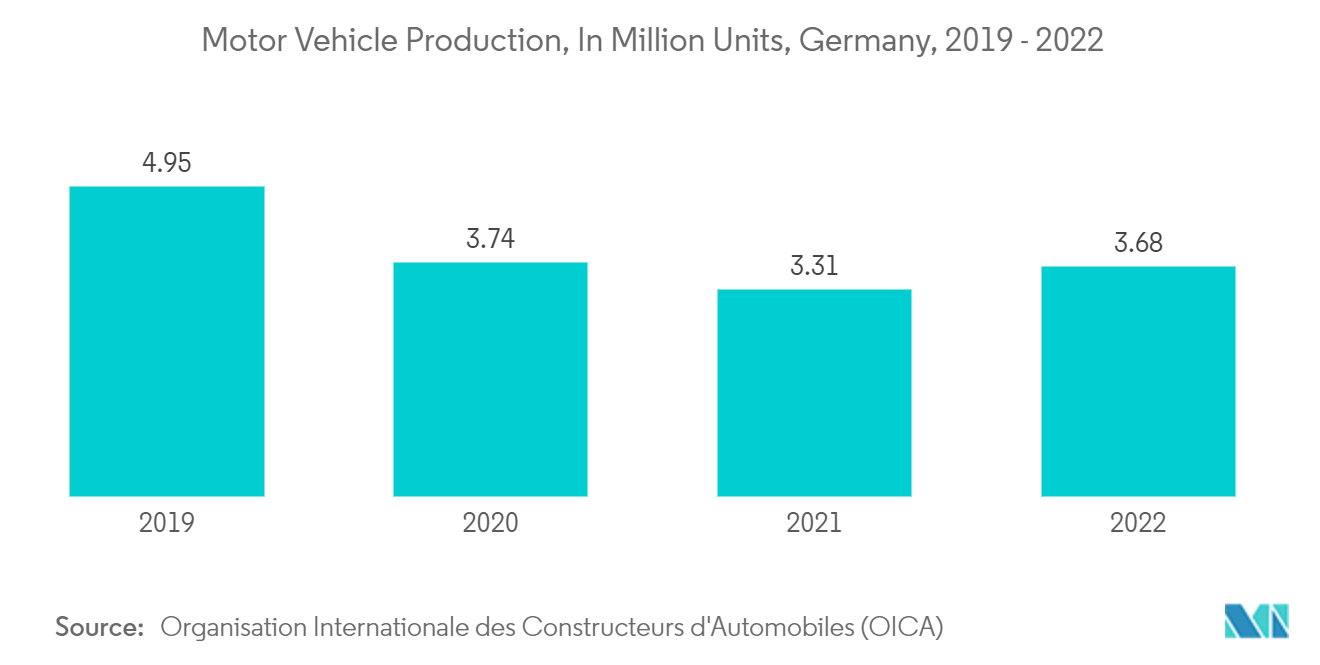
Industrial Grade to Account For Significant Growth
- Industrial-grade propylene glycol finds application in industries such as chemical manufacturing, personal care and cosmetics, and the building and construction industry.
- Germany is a leading chemical producer in the region, accounting for over 70% of Europe’s chemical exports. The German chemical industry excels in all categories, including basic inorganics, petrochemicals, polymers, agrochemicals, specialties, cosmetics, and medicines. It is also widely distributed across the country, with some locations specializing in basic chemicals and others specializing in specialties like pharmaceuticals.
- The dominant players in the German chemicals industry are BASF, Bayer, Henkel, Evonik, Covestro, Merck, Lanxess, Freudenberg, Wacker, and Atlanta. With the increasing demand from the major end-user industries, the market is projected to grow during the forecast period.
- According to the German Chemical Industry Association, the production value of the German Chemical Industry increased by about 16.03% in 2022 and was valued at EUR 146.6 billion (~USD 154.80 billion).
- According to Cosmetics Europe (the personal care association), Germany is the largest European cosmetics market. The leading players, such as L’Oréal Group, Unilever, Procter & Gamble, Beiersdorf AG, Shiseido Company, Revlon, the Estee Lauder Companies Inc., Riverderm AG, Skinceuticals Inc., and Natura & Co., hold the majority of the share in the cosmetics market.
- According to IKW, the German Cosmetic, Toiletry, Perfumery, and Detergent Association, sales of beauty and homecare products increased by 7.9% in 2022 to EUR 30.1 billion (approximately USD 32.8 billion).
- Germany has the largest construction industry in Europe. The country's construction industry has been growing slowly, driven by increasing new residential construction activities. The non-residential and commercial buildings in the country are expected to witness significant growth prospects during the forecast period. Lower interest rates, increased disposable incomes, and numerous investments by the European Union and the German government will likely support the growth.
- Also, the new German Social Democrat government focuses heavily on the country's housing crisis. The government is creating an entirely new ministry to supervise its housing plans. The government has pledged over 400,000 new housing units yearly since 2022, 100,000 of which will be publicly subsidized.
- Hence, with expanding industries, the demand in the market will subsequently increase during the forecast period.
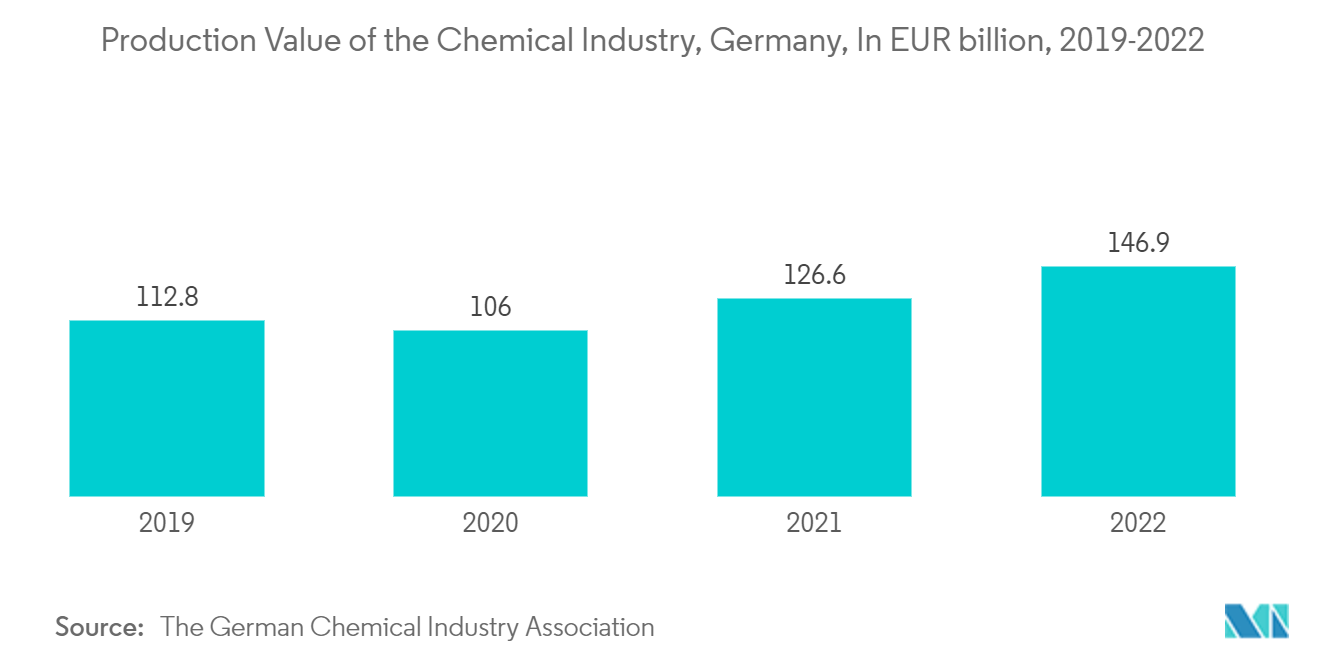
Competitive Landscape
The German propylene glycol market is consolidated. The major players (not in any particular order) include INEOS, BASF SE, Dow, Evonik Industries AG, and LyondellBasell Industries Holdings B.V.
Germany Propylene Glycol Industry Leaders
-
INEOS
-
BASF SE
-
Dow
-
Evonik Industries AG
-
LyondellBasell Industries Holdings B.V.
- *Disclaimer: Major Players sorted in no particular order
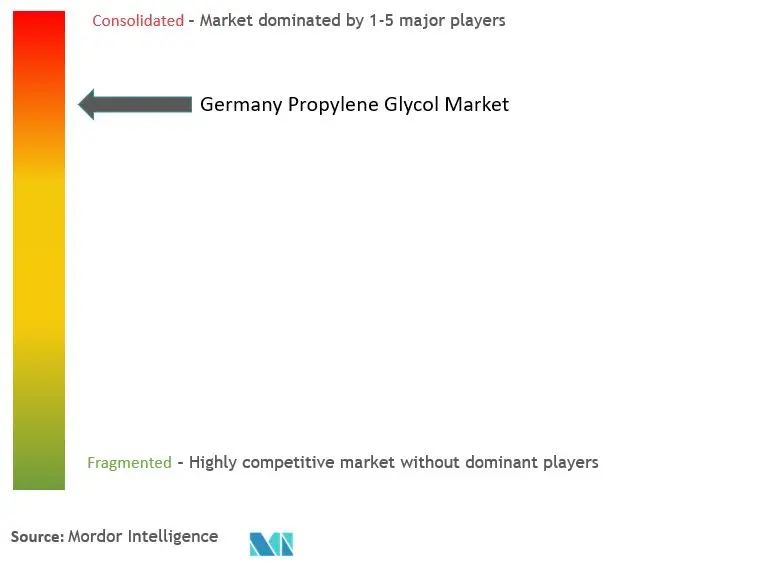
Recent Industry Developments
- October 2023: Dow and Evonik started the operation of a new pilot plant for the production of hydrogen peroxide to propylene glycol (HPPG) at Evonik’s site in Hanau, Germany.
- March 2022: MOL and HELM signed an agreement for the marketing of propylene glycols in Western Europe and overseas markets. Under the agreement, HELM will market propylene glycols produced by MOL.
Germany Propylene Glycol Market Report Scope
Propylene glycol is a viscous, colorless liquid classed as a diol. It is miscible with a broad range of solvents, including water, acetone, and chloroform, and thus finds application across a vast range of industries. Polypropylene glycol is a significant component in the production of polymers.
The propylene glycol market is segmented by grade, application, and end-user industry. The market is segmented by grade into industrial, food and beverage, and pharmaceutical. The market is segmented by application into flavoring agents, antifreeze and deicer agents, unsaturated polyester resins, chemical intermediates, and other applications (antioxidants and household care). In the end-user industry, the market is segmented into transportation, building and construction, food and beverages, personal care, pharmaceuticals, and other end-user industries (electronics, paints, and coatings). Market sizing and forecasts are made for each segment based on volume (tons).
| Industrial |
| Food and Beverage |
| Pharmaceutical |
| Flavoring Agent |
| Antifreeze and Deicer Agent |
| Unsaturated Polyester Resins |
| Chemical Intermediates |
| Other Applications (Antioxidants and Household Care) |
| Transportation |
| Building and Construction |
| Food and Beverages |
| Personal Care |
| Pharmaceuticals |
| Other End-user Industries (Electronics and Paints and Coatings) |
| Grade | Industrial |
| Food and Beverage | |
| Pharmaceutical | |
| Application | Flavoring Agent |
| Antifreeze and Deicer Agent | |
| Unsaturated Polyester Resins | |
| Chemical Intermediates | |
| Other Applications (Antioxidants and Household Care) | |
| End-user Industry | Transportation |
| Building and Construction | |
| Food and Beverages | |
| Personal Care | |
| Pharmaceuticals | |
| Other End-user Industries (Electronics and Paints and Coatings) |
Key Questions Answered in the Report
How big is the Germany Propylene Glycol Market?
The Germany Propylene Glycol Market size is expected to reach 211.66 thousand tons in 2025 and grow at a CAGR of greater than 3.5% to reach 251.38 thousand tons by 2030.
What is the current Germany Propylene Glycol Market size?
In 2025, the Germany Propylene Glycol Market size is expected to reach 211.66 thousand tons.
Who are the key players in Germany Propylene Glycol Market?
INEOS, BASF SE, Dow, Evonik Industries AG and LyondellBasell Industries Holdings B.V. are the major companies operating in the Germany Propylene Glycol Market.
What years does this Germany Propylene Glycol Market cover, and what was the market size in 2024?
In 2024, the Germany Propylene Glycol Market size was estimated at 204.25 thousand tons. The report covers the Germany Propylene Glycol Market historical market size for years: 2019, 2020, 2021, 2022, 2023 and 2024. The report also forecasts the Germany Propylene Glycol Market size for years: 2025, 2026, 2027, 2028, 2029 and 2030.
Page last updated on:
Germany Propylene Glycol Market Report
Statistics for the 2025 Germany Propylene Glycol market share, size and revenue growth rate, created by Mordor Intelligence™ Industry Reports. Germany Propylene Glycol analysis includes a market forecast outlook for 2025 to 2030 and historical overview. Get a sample of this industry analysis as a free report PDF download.
